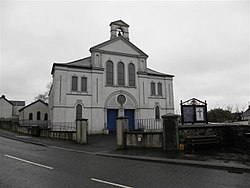Connor, County Antrim: Difference between revisions
Created page with "{{Infobox town |name=Connor |county=Antrim |picture= |picture caption= |os grid ref=J151968 |latitude=54.805990 |longitude=-6.2105262 |postcode=BT42 |post town=Ballymena |popu..." |
No edit summary |
||
| Line 2: | Line 2: | ||
|name=Connor | |name=Connor | ||
|county=Antrim | |county=Antrim | ||
|picture= | |picture=Connor Presbyterian Church - geograph-1681480.jpg | ||
|picture caption= | |picture caption=Connor Presbyterian Church | ||
|os grid ref=J151968 | |os grid ref=J151968 | ||
|latitude=54.805990 | |latitude=54.805990 | ||
Latest revision as of 19:33, 15 November 2017
| Connor | |
| County Antrim | |
|---|---|
 Connor Presbyterian Church | |
| Location | |
| Grid reference: | J151968 |
| Location: | 54°48’22"N, 6°12’38"W |
| Data | |
| Post town: | Ballymena |
| Postcode: | BT42 |
| Local Government | |
| Council: | Mid & East Antrim |
Connor is a small village standing just to the east of Kells in the west of County Antrim.
The name of the place is from the Irish Coinnire, meaning "(Wild) dog oak-wood"[1] In Ulster-Scots it is known as 'Connyer'. The 9th-century Martyrology of Oengus remarks that of the name, appearing as Condeire as ‘wolf-oakwood' and since 'there was an oak wood there formerly and in this (wood) wolves lived’[1][2]
Kells and Connor share many facilities and had a combined population of 2,053 at the 2011 Census.
History
There is much evidence, from written sources and archaeological material, that Connor was a sizeable, complex settlement in the Early Christian period, probably with monastic and secular elements coexisting. The name of the church here is recorded in the Annals of Ulster in 507, which record the death of the bishop Mac Nissi Condaire episcopi ('MacNissi, Bishop of Connor'), which event though the Annals of the Four Masters record for the year 513 (corrected by scholarship to 514).[1]
The church of the early monastic establishment at Connor was re-built as the cathedral of the mediæval Diocese of Connor and Kells.
In the Middle Ages the townland of Connor was accounted one of the "the ‘sixteen towns of Connor", which is to say one of sixteen townlands in the vicinity of the cathedral of Connor which were the property of the bishop.[1][3] An Augustinian community was established at Kells nearby, which abbey survived into the early seventeenth century, being burnt down 1641.
Connor was the site of a significant battle between the invading army of Edward Bruce and Richard Óg de Burgh, 2nd Earl of Ulster, on 9 September 1315. Following the defeat of the Anglo-Normans by the Scottish army, Connor was sacked.
The monastic church was destroyed in the Confederate wars of the mid seventeenth century and replaced by the present Church of St Saviour early in the nineteenth century: the foundation stone for the church was laid in 1811 and the building consecrated in 1813.
In 1859 the Ulster Revival began in Kells and in Connor.[4]
Outside links
References
- ↑ 1.0 1.1 1.2 1.3 Connor, County Antrim - Placenames NI
- ↑ Fél. Oeng. Sep. 3n p.198
- ↑ O’Laverty iii 285
- ↑ Kells and Connor to mark 1859 revival': Ballymena Times 16 January 2009